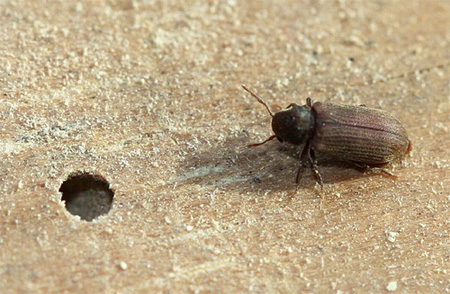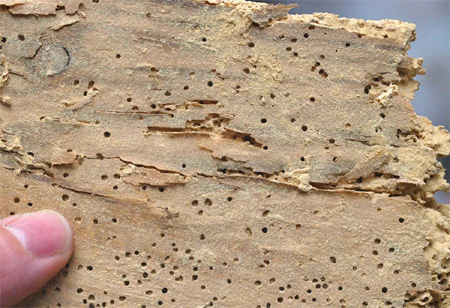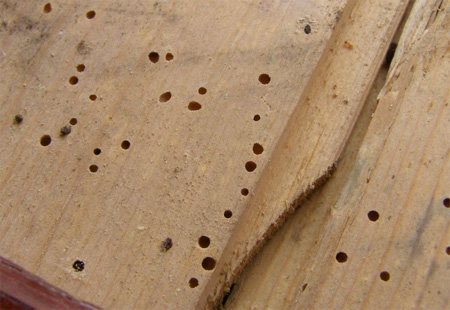Timber and wood full of holes?
The name may cause some confusion, especially since it isn't a worm at all but rather grubs of the Common Furniture Beetle [Anobium punctatum]. But confusion aside, woodworm can cause extensive damage to your home and furniture if left untreated.
This beetle is right at home in a damp, debris strewn forest floor, so it's unusual to find it in timber used for home building, especially when that timber is kiln dried and treated. Or is it?
When wood is moist it is the perfect environment for fungal and microbial attack, and creates the perfect home for woodworm, where it reduces wood to hollowed-out beams in no time.
In most timber used for construction, conditions are not usually ideal and any infestation will slowly die out. On the other hand, just a small amount of moisture and woodworm will thrive.
In older homes, that means particular care is required under poorly ventilated floors, bathrooms, laundry and similar environments where timber is installed. It’s not unusual to find a light to moderate infestation in a house and then discover that the sections of floor under the kitchen sink or bathtub are very heavily infested, often with structural damage.
GOOD TO KNOW
Timber quickly absorbs moisture vapour from air – it does not need to be physically splashed with water to become moist.
BELOW: A sure sign of woodworm infestation. When performing an inspection, shine a torch at an angle to shed light across the surface for a better chance of seeing damage.
preservationexpert.co.uk
The problem is compounded by the female insects habit of laying eggs in the old flight holes left from the previous generation. Thus the infestation gets going faster in damp areas, then accelerates again with each laying season.
Inspect for woodworm
Underneath the floor is the best place to look for the small holes, but if that’s not very accessible, try looking around the edges, especially under windows (adults usually fly to light and white colours like window sills), around the base of the toilet, next to the shower tray etc., here is where the holes will eventually appear, even if the first generation emerged elsewhere.
Cellars are a high risk. The cellar ceiling may be made of lime plastered timber laths. If woodworm is in these, it emerges into the void above, which is a cosy environment and they have a good chance of meeting the love of their lives and laying eggs in the void – concentrating the infestation. Joinery in cellars may be unpainted and will have a higher moisture content, so check it all.
preservationexpert.co.uk
The entire roof should be checked , but for starters try the ceiling joists and the spars next to the chimney.
On timber staircases, l look at the edges of the treads in particular; the treads and rises are often ‘flat sawn’ so the curved (bullnose), edge of the treads may have a high sapwood content, which is ideal for woodworm to thrive in. Do look at the stair strings and joinery too though.
How to treat woodworm
Is the woodworm active? Summer is the season of love, but the period is a bit flexible in houses, due to heating and such, so you may get fresh holes anytime between about September through to May. New holes are usually part filled with ‘frass’ which is the excretion by woodworm of undigested wood. A trained specialist can identify the species of the infestation just from the texture, size and colour of the pellets. The size and shape of the ‘flight holes’ is also crucial of course.
preservationexpert.co.uk
If you suspect an infestation of woodworm call in a specialist contractor, or preservation expert, who has experience in this field. They will provide a recommendation based on sensible methodology – it is not good practice to just recommend treatment whenever flight holes are found. If a surveyor recommends treatment or diagnoses woodworm and does not recommend treatment, ask why – he should have a reason for any recommendation.
Modern treatments include a variety of chemicals, though for most infestations I recommend a Permethrin based insecticide. Permethrin is a synthetic pyrethroid with very low mammalian toxicity (cats excepted), It kills woodworm stone cold though. It is a contact insecticide so it will protect wood from re-infestation and will kill adults emerging from below during the flight season. A thorough spray to ‘run off’ is all that’s required.
Boron products work well too, though these need to be ingested so are less effective on severe infestations; they have a dual action though, inhibiting fungal growth too. It’s a question of balance and a decent timber infestation surveyor will make a judgement on the most appropriate product.
Woodworm and furniture
When buying wood furniture - or if you own vintage wood - furniture check for tiny holes about 1 to 2mm in diameter - the first indication of woodworm. These small holes are exit holes that an adult beetle uses to move on, after spending up to five years tunnelling through it as a grub. These holes may also contain eggs waiting to hatch and that were left behind by the exiting female beetle. Another telltale sign of active woodworm is "frass" - tiny piles of light coloured powder, which is actually of wood that the woodworm couldn’t digest. If the piece is an antique, it is best to let an antique restorer attend to the problem. However, if you cannot afford to send it in to an antique restorer there are some tried and trusted methods you can try:
Treatment for wood furniture
Start by turning the piece upside down and flushing mineral turpentine fluid into all visible holes. As it drains into the tunnels, add more mineral turpentine. You will also need to treat around glued sections, such as underneath the frame, as these are often of softwood and particularly susceptible to attack, as well as the bottom of legs or feet - an ideal spot for eggs to be laid. Place the piece outdoors and allow furniture to dry thoroughly before using it. Repeat this process a couple of times to ensure complete eradication of any infestation.
For extensive damage it's a good idea to pour wood glue down the holes and then top this off with a plug of wood filler in a matching shade. Thereafter, you should seal the wood with a quality sealer, such as Woodoc 5 or 10 interior sealer, or apply Penetrating Wax or Antique Wax.




